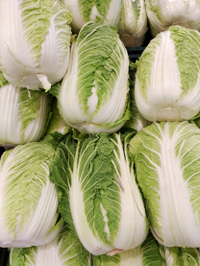
Photo from wikipedia
The ethylene response factor (ERF) and phytohormone jasmonate (JA) are reported to function in leaf senescence. The involvement of ERF in JA-mediated leaf senescence, however, needs to be elucidated. In… Click to show full abstract
The ethylene response factor (ERF) and phytohormone jasmonate (JA) are reported to function in leaf senescence. The involvement of ERF in JA-mediated leaf senescence, however, needs to be elucidated. In the present work, we demonstrate a Chinese flowering cabbage ERF transcription factor (TF), BrERF72, that is associated with JA-promoted leaf senescence. Exogenous application of methyl jasmonate (MeJA)-accelerated leaf senescence of Chinese flowering cabbage, evidenced by the data that MeJA treatment led to the stronger reduction in the maximum quantum yield (Fv/Fm), photosynthetic electron transport rate (ETR), and total chlorophyll content, while significant induction in the expression of several senescence-associated genes (SAGs) including BrSAG12, BrSAG19, and chlorophyll catabolic genes (CCGs) BrPAO1, BrNYC1, BrPPH1, and BrSGR1. Increases in levels of endogenous JA and transcripts of JA biosynthetic genes BrLOX4, BrAOC3, and BrOPR3 were also found after MeJA treatment. BrERF72 was a MeJA-inducible, nucleus-localized protein, and possessed trans-activation ability. Transient overexpression of BrERF72 in tobacco leaves also promoted leaf senescence. More importantly, further experiments revealed that BrERF72 directly activated expression of BrLOX4, BrAOC3, and BrOPR3 through binding to their promoters via the GCC or DRE/CRT cis-element. Together, the novel JA-ERF association reported in our study uncovers a new insight into the transcriptional regulation of JA production mediated by ERF during JA-promoted leaf senescence in Chinese flowering cabbage.Crop genetics: the secrets of aging in leavesResearchers in China have uncovered a gene involved leaf aging in response to the plant hormone jasmonate in Chinese flowering cabbage. A team led by Jian-ye Chen of the South China Agricultural University treated Chinese flowering cabbage with jasmonate, which is known to promote leaf senescence in other species. In addition to accelerating senescence, the treatment caused the cabbage to produce more jasmonate. The team also used RNA sequencing to discover a new transcription factor, BrERF72, linking jasmonate and leaf senescence. BrERF72 is active during leaf senescence and was more strongly expressed in jasmonate-treated leaves. The team found that BrERF72 activates jasmonate biosynthesis genes, potentially creating a feedback loop reinforcing senescence. These findings extend our understanding of how leaves age, which will help improve breeding, treatment, and storage of leafy crops.
Journal Title: Horticulture Research
Year Published: 2018
Link to full text (if available)
Share on Social Media: Sign Up to like & get
recommendations!